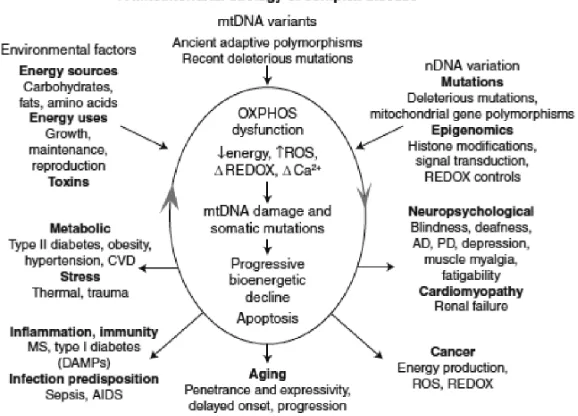31 Supplement J Med Sci, Volume 48, No. 4, 2016 October
Mitochondrial genetics and cancer
Safarina G. Malik*
Eijkman Institute for Molecular Biology Jl. Diponegoro no. 69, Jakarta 10430, Indonesia
DOI: http://dx.doi.org/10.19106/JMedScieSup004804201628
ABSTRACT
The irst modern human, the Mitochondrial Eve, was traced back to Africa about 200,000 years ago, based on the variation in the mitochondrial DNA (mtDNA). The eruption of Mount Toba super-volcano in Sumatra 70,000 years ago may have led to a ‘nuclear winter’, followed by a 1,000-year ice age. This cold snap would have made life dificult; genetic evidence indicated a sharp reduction in
population size around this time, reaching approximately 10,000 individuals. Once the climate started to improve, our ancestors recovered from this near-extinction
event. The population expanded, and some courageous explorers ventured beyond
Africa. Around 50,000 years ago some of these brave ancestors had successfully crossed the globe to South East Asia and Australia. Some of them settled in the Indonesian archipelago, forming the irst settlement of prehistoric Indonesia. The second migration happened around 10,000 years ago, where a group of hunter-gatherers followed the now-submerged river systems that once ran from
mainland Asia between the modern islands of Sumatera, Java, and Borneo. Then, around 4,000 years ago the third group of ancestors arrived. This agricultural
community brought along their culture of pottery, plant cultivation, and animal domestication, occuring in coincidence with the vast spread of Austronesian
languages. Therefore, it is likely that the Indonesian archipelago hosted a wide
range of linguistic, ethnic and genetic diversity.Nowadays, the modern Indonesia is home to around 700 ethnic populations, each with distinct cultural and linguistic characteristics, representing vast genome diversity.
Our ancestors’ decision to embark on sea travel and take on its related lifestyle has
inluenced the development of susceptibility and resistance to various diseases
observed today. During the prolonged travel, our ancestors were subjected to
changes in global climate and geographic dynamic, which strongly inluenced and
shaped the genetic background of modern humans, including the mtDNA genome. Mitochondria, a well-adapted endosymbiotic intracellular organelles, became
eficient for energy production throughout the course of evolution. They are
critical for survival and proliferation of living organisms under aerobic conditions
and produce ATP through oxidative phosphorylation (OXPHOS). Adaptation to new environments that favor beneicial traits might have caused genetic risk differences that inluence the crucial function of the mitochondria, consequently affecting many functions in the cell. The altered function of the mitochondria
might act as an important factor for disease susceptibility across many human populations, i.e. mtDNA variation grouped together to form a certain type/group (the mtDNA haplogroup) was reported to modulate cancer susceptibility and resistance in Chinese population.
Supplement J Med Sci, Volume 48, No. 4, 2016 October
32
Cancer cells are characterized in general by a decrease of mitochondrial respiration
and OXPHOS, a consequence of disruptive mtDNA mutations, thus one might afirm that the growth of cancer cells is directly limited by cellular energetics.
In order to survive, cancer cells must modify their mitochondrial physiology to
optimize energy production towards their changing environments. There are
two types of advantageous mtDNA mutations for cancer cells: mutations that
impair OXPHOS and serve to stimulate neoplastic transformation, and those that facilitate cancer cell adaptation to altered bioenergetics environment. These
mtDNA mutations would eventually lead to an enhanced generation of reactive oxygen species (ROS), which acts both as mutagens and cellular mitogens, and contribute directly to cancer progression. Therefore, it can be concluded that mitochondrial alterations are critical for cancer initiation, promotion, and metastasis (Fig 1).
Top three arrows: factors that have impact on mitochondrial OXPHOS robustness,
risk for developing disease symptoms. Central oval arrows: pathophysiological basis of disease processes and the basis of disease progression. Lower ive
arrows: summarized disease categories and phenotypic outcomes of disturbed mitochondrial energy transformation. Bottom arrow: effect of the problematic accumulation of somatic mtDNA mutations resulting in delayed-onset and progressive course of diseases and aging. Right arrow: clinical problems that can result from reduced energy production in the most energetic tissues: the brain, heart, muscle, and kidney. Left arrow: indicates the metabolic effects of mitochondrial dysfunction, which result in the perturbation of the body’s energy balance. Lower right arrow: mitochondrial alterations are critical for cancer initiation, promotion, and metastasis. Lower left arrow: the hypothesized inlammatory and autoimmune
responses that may result from chronic introduction of mitochondria’s bacteria-like DNA and N-formylmethionine proteins into the bloodstream.
